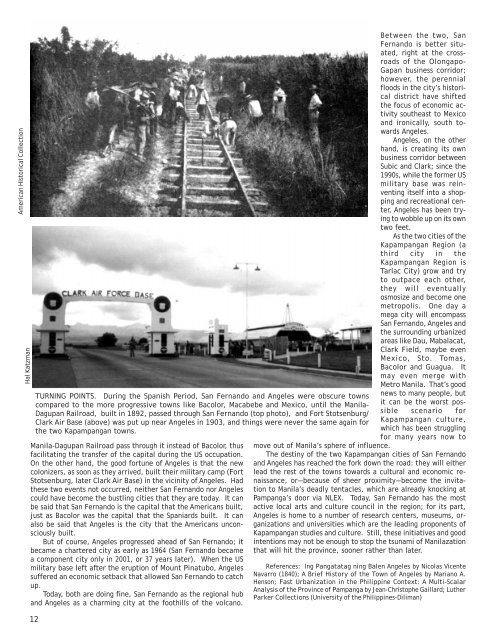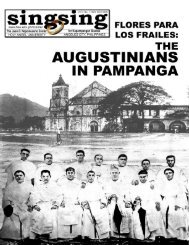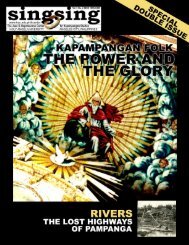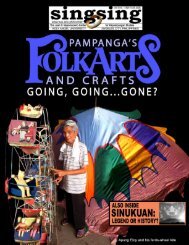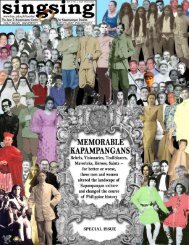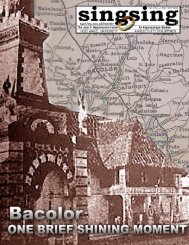Download PDF - Holy Angel University
Download PDF - Holy Angel University
Download PDF - Holy Angel University
Create successful ePaper yourself
Turn your PDF publications into a flip-book with our unique Google optimized e-Paper software.
American Historical Collection<br />
Hal Katzman<br />
Manila-Dagupan Railroad pass through it instead of Bacolor, thus<br />
facilitating the transfer of the capital during the US occupation.<br />
On the other hand, the good fortune of <strong>Angel</strong>es is that the new<br />
colonizers, as soon as they arrived, built their military camp (Fort<br />
Stotsenburg, later Clark Air Base) in the vicinity of <strong>Angel</strong>es. Had<br />
these two events not occurred, neither San Fernando nor <strong>Angel</strong>es<br />
could have become the bustling cities that they are today. It can<br />
be said that San Fernando is the capital that the Americans built,<br />
just as Bacolor was the capital that the Spaniards built. It can<br />
also be said that <strong>Angel</strong>es is the city that the Americans unconsciously<br />
built.<br />
But of course, <strong>Angel</strong>es progressed ahead of San Fernando; it<br />
became a chartered city as early as 1964 (San Fernando became<br />
a component city only in 2001, or 37 years later). When the US<br />
military base left after the eruption of Mount Pinatubo, <strong>Angel</strong>es<br />
suffered an economic setback that allowed San Fernando to catch<br />
up.<br />
Today, both are doing fine, San Fernando as the regional hub<br />
and <strong>Angel</strong>es as a charming city at the foothills of the volcano.<br />
12<br />
Between the two, San<br />
Fernando is better situated,<br />
right at the crossroads<br />
of the Olongapo-<br />
Gapan business corridor;<br />
however, the perennial<br />
floods in the city’s historical<br />
district have shifted<br />
the focus of economic activity<br />
southeast to Mexico<br />
and ironically, south towards<br />
<strong>Angel</strong>es.<br />
<strong>Angel</strong>es, on the other<br />
hand, is creating its own<br />
business corridor between<br />
Subic and Clark; since the<br />
1990s, while the former US<br />
military base was reinventing<br />
itself into a shopping<br />
and recreational center,<br />
<strong>Angel</strong>es has been trying<br />
to wobble up on its own<br />
two feet.<br />
As the two cities of the<br />
Kapampangan Region (a<br />
third city in the<br />
Kapampangan Region is<br />
Tarlac City) grow and try<br />
to outpace each other,<br />
they will eventually<br />
osmosize and become one<br />
metropolis. One day a<br />
mega city will encompass<br />
San Fernando, <strong>Angel</strong>es and<br />
the surrounding urbanized<br />
areas like Dau, Mabalacat,<br />
Clark Field, maybe even<br />
Mexico, Sto. Tomas,<br />
Bacolor and Guagua. It<br />
may even merge with<br />
Metro Manila. That’s good<br />
news to many people, but<br />
it can be the worst possible<br />
scenario for<br />
Kapampangan culture,<br />
which has been struggling<br />
for many years now to<br />
move out of Manila’s sphere of influence.<br />
The destiny of the two Kapampangan cities of San Fernando<br />
and <strong>Angel</strong>es has reached the fork down the road: they will either<br />
lead the rest of the towns towards a cultural and economic renaissance,<br />
or—because of sheer proximity—become the invitation<br />
to Manila’s deadly tentacles, which are already knocking at<br />
Pampanga’s door via NLEX. Today, San Fernando has the most<br />
active local arts and culture council in the region; for its part,<br />
<strong>Angel</strong>es is home to a number of research centers, museums, organizations<br />
and universities which are the leading proponents of<br />
Kapampangan studies and culture. Still, these initiatives and good<br />
intentions may not be enough to stop the tsunami of Manilazation<br />
that will hit the province, sooner rather than later.<br />
TURNING POINTS. During the Spanish Period, San Fernando and <strong>Angel</strong>es were obscure towns<br />
compared to the more progressive towns like Bacolor, Macabebe and Mexico, until the Manila-<br />
Dagupan Railroad, built in 1892, passed through San Fernando (top photo), and Fort Stotsenburg/<br />
Clark Air Base (above) was put up near <strong>Angel</strong>es in 1903, and things were never the same again for<br />
the two Kapampangan towns.<br />
References: Ing Pangatatag ning Balen <strong>Angel</strong>es by Nicolas Vicente<br />
Navarro (1840); A Brief History of the Town of <strong>Angel</strong>es by Mariano A.<br />
Henson; Fast Urbanization in the Philippine Context: A Multi-Scalar<br />
Analysis of the Province of Pampanga by Jean-Christophe Gaillard; Luther<br />
Parker Collections (<strong>University</strong> of the Philippines-Diliman)


